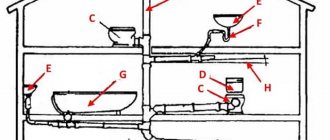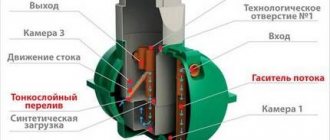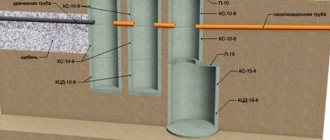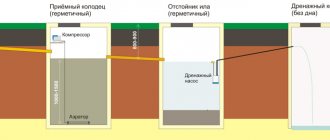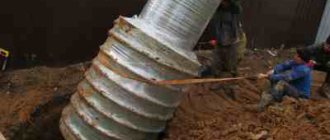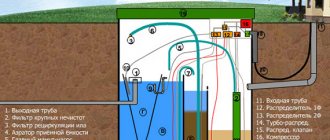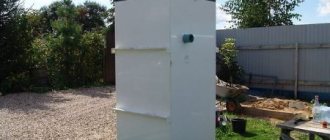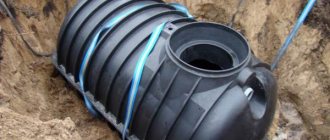The problem of waste disposal arises in any room used for housing, be it a holiday cottage on weekends or a house in which the family will live permanently. The most successful solution for suburban housing is the installation of a septic tank - an installation that will accumulate and purify wastewater. This option also attracts homeowners because settling chambers can be built independently. Unfortunately, not all areas have ideal conditions for building a septic tank. Let's look at how to make a septic tank if the groundwater lies close to the surface.
When planning the construction of utility lines for a house or cottage, it is imperative to take into account the conditions on the ground. One of the most important indicators is the groundwater level - groundwater level.
If the groundwater is located below three meters from the surface, then the question of how to make a septic tank from concrete rings is easily resolved. But the groundwater level can be very high - 1 meter from the surface or even higher. In this case, it is not recommended to use the option of installing chambers from well rings, since it will be extremely difficult to achieve the tightness of the septic tank.
How to determine how close it is
The first thing to do is to identify the GWL and understand the scale of the problem.
Important: the liquid comes as close to the surface as possible in spring and autumn. In the first case, the cause is melting snow, in the second - prolonged rains.
Here are 5 ways to determine it:
- The easiest way is to ask local residents. Perhaps the neighbors already know at what depth the water supply system is located or they have a well on their property.
- Flora as a guide. Certain types of plants can only survive when water gets close enough to the surface. The following table will help you navigate:
groundwater level, mm Plants 0-500 carex (sedge), reed, wild rosemary 500-1000 рhalaris, foxtail, reed 1000-1500 spruce, heather, blackberry, fescue from 1500 and below alfalfa, plantain, clover, lingonberry - Inspection of the site. If wetlands are present, it means that the groundwater level is located close to the surface or the soil is too clayey. And also inspect the area adjacent to the site.
- The old-fashioned way. To do this, you will need a clay pot, a tuft of wool, degreased white spirit and an ordinary chicken egg. Use a shovel to remove a small layer of turf in the area where the septic tank will be located. Place wool, an egg on top and cover with a pot. An inspection is carried out in the morning. If drops of water are clearly visible on the egg, the water level is close to the surface.
- Drilling pits at several points in a suburban area. This method is quite labor intensive. But it is 100% reliable. Step-by-step instruction:
- Find a good long drill - at least two meters - and a level pole, on which you apply marks every 100 mm.
- Determine drilling points on the site. You should not drill a well only in the intended location of the sump. It is possible that it will have to be moved, so select several points throughout the site.
- Drill wells. Place waterproof material on top so that precipitation cannot enter the shaft. Wait 24 hours.
- Using a prepared pole, determine the groundwater level: immerse it in the well, reaching the bottom, pull it out and subtract the length of the wet part from the depth of the shaft.
Folk signs also help a lot.
This is especially true in the summer, when drilling cannot guarantee 100% accuracy of measurements. The fact is that in hot weather the liquid drains into nearby bodies of water and the level sometimes drops – quite significantly. Places of possible flooding will help identify midges that sense the proximity of moisture and will swarm in this particular place. You can also navigate by the abundance of dew in the morning and the density of fog in the evening. The more clearly these signs appear, the closer the liquid is to the surface. Obviously, when constructing any underground structures, it is advisable to avoid such places.
A similar situation with a drop in liquid level is observed in the middle of winter. Only the reason is not in water drainage, but in the freezing of the top layer of soil during severe frosts. Measurements taken during this period can be easily misleading. With heavy rainfall, the liquid level in spring can increase 2–3 times.
Important: if possible, the groundwater level should be determined several times a year and the lowest value taken for calculations.
Determination of water level
Before asking yourself how to make a septic tank if groundwater is close, you need to find out how close it is. It is better to measure this parameter in the spring when the snow is melting or in the fall, when there have been prolonged downpours. The actual measurement is carried out in a well, which is independently filled with groundwater. The distance between the soil level and the water surface is the desired groundwater level.
Advice! If there is no well, then it will have to be modeled. To do this, you need to drill holes in 3-4 points of the site until water comes out, and observe the filling, the average value for all holes will tell the water level.
The simplest option is to talk about this issue with neighbors who have been living on plots nearby for a long time. In some regions of the country, the groundwater level is about 20-30 cm, which is critical and needs to be known in advance. This suggests that septic tanks for dachas with a high groundwater level can only be used as sealed ones and the wastewater from them will have to be pumped out at regular intervals.
Another reliable method is to carefully consider what plants grow on the site. Horsetail and alder indicate that groundwater is high. In any case, to obtain reliable information, you should obtain data from different sources.
Determining the groundwater level using a drill
Requirements for a treatment device at high groundwater level
- The case is made of durable plastic and must be sealed.
- The structure should have a small height.
- The volume of the tank must correspond to the daily flow rate multiplied by three.
- Septic tanks intended for high groundwater must be securely fixed to a concrete base.
The following types of septic tanks are ideal for draining sewage during VUGV:
- Sealed storage container. Most often, a factory-made plastic design is used. It is guaranteed not to leak and can have a volume of up to 300 liters. This system is good in a country house or in a small private house if the owners live there periodically. But it will not solve the problem of permanent residence of a large family. The main disadvantage of this septic tank design is the regular pumping of sewage.
- Three-section anaerobic device . The first compartment (settlement tank) serves to separate waste into fractions as a result of the separation of fats and the precipitation of solid parts. In the last two, preliminary wastewater treatment occurs. An overflow pump supplies waste from one compartment to another. It is impossible to dispose of waste without additional filtration through the ground, as this leads to a violation of sanitary standards.
- VOC (local treatment plant). The waste goes through a full cycle of biological treatment. With the help of bacteria, wastewater breaks down into sludge and water. Such devices are quite expensive, but the costs are worth it; if you install such a system on your site, you can forget about pumping the sewerage system for many years.
Expert advice:
Modern treatment facilities are usually 10% more expensive. These septic tanks are equipped with all the necessary filters for high cleaning efficiency of up to 98%.
Reinforced polypropylene septic tanks have a sealed pump compartment for discharging purified water onto the ground or into a drainage ditch.
A prominent representative of such septic tanks is the Super septic tank Tver, which does not have the above-mentioned disadvantages of a septic tank made of concrete rings. This septic tank is effective, reliable, and unpretentious in operation.
Required tools and materials
Below we will consider in more detail the process of installing a storage sump. For self-installation you will need the following tools:
- motor pump;
- shovels;
- metal cable;
- building level;
- jigsaw
You need to prepare the following materials:
- wooden or metal tongue and groove;
- boards for formwork, AIII reinforcement Ø12 mm, B12.5 concrete (with a monolithic foundation) or prefabricated reinforced concrete slab;
- clamps for attaching the container to the base;
- sealant.
Industrial production models
Numerous reviews allow us to identify three current septic tanks for drainage near groundwater. This:
- Septic tank called "Tank"
from the manufacturer Triton Plastic. The model is made of plastic, has three sections in the body, where in the first two cleaning is carried out by overflowing and settling the contents, and in the third section anaerobic bacteria come into play.
- "Mole"
. It is produced by the Aqua-Master company. This option is better suited for installation with water-water treatment, since the hull is initially protected from floating, and the design implies the presence of a biofilter.
- Septic tank Bioton B
. This option of a septic tank is considered the most relevant for working with a close water supply system. Its design not only includes a biofilter, but also has a three-section structure. In one of the sections you can place a sewage pump to pump out liquid. Biton B involves constructing a pit with a slope from the perimeter.
DIY installation and work plan
Installation of a sump consists of the following steps:
- Development of a pit and installation of forced drainage (the features are discussed in more detail above).
- The pit slopes are fastened to ensure safety and protection from collapse. There should be no liquid in the pit during work. It is pumped out using a motor pump. But overnight it picks up again. This can lead to the collapse of the walls if they are not secured.
- Installation of a concrete slab or concreting the base. The process is as follows:
- The bottom of the pit is leveled using a building level for control.
- Then an underlying layer of sand 150 mm thick is arranged. The sand is spilled with water and thoroughly compacted.
- The next layer is waterproofing. Experts recommend using two layers of roofing felt.
- Formwork and reinforced frame are installed on the waterproofing, and concrete is poured. It must be laid in even layers, vibrating. It is advisable not to stop work for more than 4 hours. If conditions allow the passage of equipment, you can use a ready-made reinforced concrete slab, which will significantly reduce labor intensity. With a monolithic structure, you need to leave embedded parts in the concrete body to secure the tank.
- We install the finished plastic container on the prepared base, having previously calculated the required volume and checked its tightness. We use special clamps to secure the tank to the embedded parts of the “foundation” using welding or bolts. Now you don’t have to worry about it popping up.
- We connect the supply pipe, carefully seal all joints and insulate the septic tank and all pipelines.
- We carry out backfilling with protection from soil heaving as a result of a difference in groundwater level (a mixture of sand and cement with layer-by-layer spillage and compaction).
Important:
- A layer of expanded clay with a thickness of at least 200 mm should be poured around the container. This will prevent freezing and reduce the negative impact of external factors.
- During backfilling, you need to gradually fill the container with liquid so that the water level is always above the backfilled level. This method can protect the septic tank from damage.
Purpose
A septic tank, in fact, is a combination of a cesspool and a treatment plant, which receives wastewater generated during the life of residents of private housing construction. As a result of using toilets, bathtubs, washing machines and dishwashers, a large amount of waste is generated that must be disposed of without harming the environment.
Modern septic tanks provide accumulation, biological treatment, and disposal of wastewater in two stages:
- Contaminated wastewater enters the first chamber of the tank, where it settles and undergoes primary purification. Solid heavy particles quickly sink to the bottom, and the water purified from them flows into the next chamber.
- In the second chamber, the organic compounds that make up the sewage are decomposed with the help of anaerobic microorganisms. The water becomes even cleaner and enters a third tank or a system of special filters for final purification.
Understanding the operating principle of a septic tank will greatly facilitate the selection and installation of a septic tank for the owner of a suburban area.
Maintenance and operation
The operation of a septic tank in VUGV conditions, as well as installation, requires special measures:
- It is forbidden to clog the system with large debris. This will cause clogging.
- The sewer pipe and sump tank must be thoroughly insulated.
- Drains need to be pumped out regularly. Do not allow the tank to be filled more than 2/3 full.
- When using bacteria as a natural filter, it is worth remembering that any chemical will kill them.
Following these simple rules will make the operation of the sewer system easy and eliminate unnecessary problems and unpleasant odors.
Autonomous sewerage is the only way out at high groundwater levels.
Choosing a location for a septic tank
To determine the optimal location for constructing a septic tank, you should study the current rules and regulations. There are several conditions that must be taken into account:
- the septic tank must be located at least 5 meters from the house or any building (see more about the distance of the septic tank to other objects);
- the road zone should be located at a distance of 5 meters;
- the sewerage and aeration station must be located at a distance of 30 meters from an open reservoir or reservoir and 50 meters from a well with drinking water.
